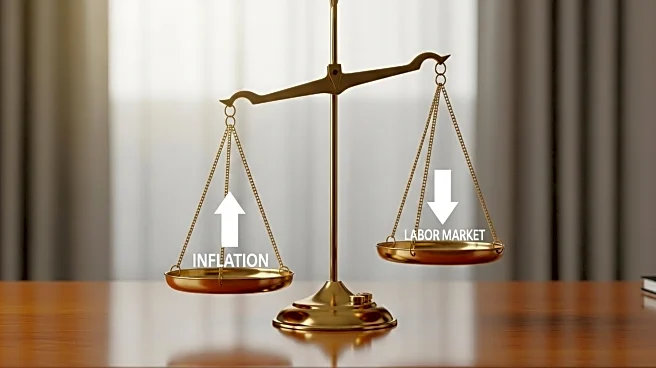What's Happening?
The U.S. nonfarm payrolls report for August 2025 revealed a significant slowdown in job growth, with only 22,000 jobs added compared to the expected 75,000. This has led to increased expectations for a Federal Reserve rate cut at the upcoming September 16-17 FOMC meeting. Futures markets are now pricing in a 65% probability of three 25-basis-point reductions by December. The weak labor data, coupled with inflation above the 2% target, has eroded confidence in the Fed's ability to achieve a 'soft landing.' As a result, global equity markets are experiencing shifts, with investors adjusting portfolios to take advantage of potential rate cuts.
Why It's Important?
The anticipated rate cuts by the Federal Reserve could have significant implications for various sectors of the U.S. economy. Defensive sectors like healthcare and utilities are expected to benefit, as they offer stability in uncertain economic conditions. Conversely, growth-oriented sectors such as technology and consumer discretionary may face challenges due to rising borrowing costs. Additionally, highly leveraged industries like real estate and regional banks could experience margin compression. The potential rate cuts are also influencing global markets, with investors seeking to diversify into non-dollar assets and commodities to hedge against inflation and geopolitical risks.
What's Next?
Investors are likely to continue adjusting their portfolios in anticipation of the Federal Reserve's decisions. Strategies may include increasing exposure to defensive sectors, commodities, and international equities to mitigate risks associated with economic volatility. The upcoming FOMC meeting will be closely watched, as further rate cuts could reshape market dynamics and influence investment strategies. Stakeholders will need to remain vigilant about sectoral divergences and macroeconomic headwinds as they navigate the evolving financial landscape.
Beyond the Headlines
The potential rate cuts highlight the challenges faced by the Federal Reserve in balancing economic growth with inflation control. The central bank's actions could have long-term implications for monetary policy and financial stability. Additionally, the shift in investor focus towards defensive sectors and commodities underscores the need for strategic asset allocation in response to changing economic conditions.












